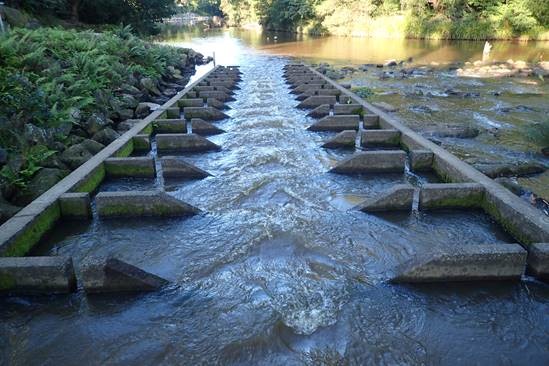|
|
Trapezoidal fishwayTrapezoidal fishway – Planning and design Select from the tabs below In addition to the general information for all fishway types, the following applies to trapezoidal fishways. Given there are few trapezoidal fishways in Australia, planning and design is mostly based on vertical slot fishways. SlopeA slope of 1:30 (vertical:horizontal) is typically used for the passage of small-bodied species through a vertical slot or trapezoidal fishway. Where an additional fish passage structure is provided for this size range (i.e. a fish lock), the slope of the accompanying fishway is typically increased to 1:18[2]. Water velocity and turbulenceWater velocity is related to head loss. The maximum head loss between pools for an inland trapezoidal fishway is typically 100 mm for the passage of small fish. The vertical drop between each pool, the size (volume) of the pool, and the width of the slot connecting each pool determines the turbulence and velocity parameters of the fishway, which in turn determine the size and species of fish that are capable of utilising the fishway[1]. Long trapezoidal fishways can include resting pools to allow for fish that may not complete their ascent during daylight or may descend the fishway when the light fades. Resting pools may enable fish to remain in the fishway overnight in a long fishway, however, more data are required. Resting pools typically have four times the volume of standard pools and occur every 1 m rise in vertical elevation[3]. Disclaimer: In addition to the standard disclaimer located at the bottom of the page, please note the Fishways (biopassage structures) disclaimer. References
Last updated: 10 May 2021 This page should be cited as: Department of Environment, Science and Innovation, Queensland (2021) Trapezoidal fishway – Planning and design, WetlandInfo website, accessed 8 May 2025. Available at: https://wetlandinfo.des.qld.gov.au/wetlands/management/fish-passage/technologies/fishway-options/trapezoidal/planning-design.html |

 — Department of the Environment, Tourism, Science and Innovation
— Department of the Environment, Tourism, Science and Innovation

